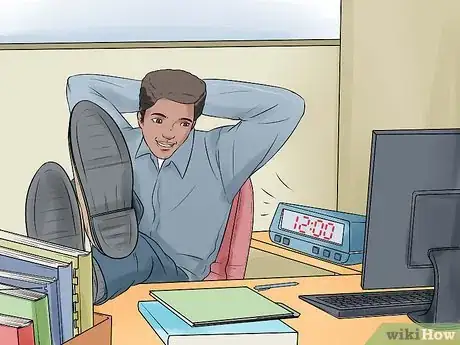This article was co-authored by Trudi Griffin, LPC, MS. Trudi Griffin is a Licensed Professional Counselor in Wisconsin specializing in Addictions and Mental Health. She provides therapy to people who struggle with addictions, mental health, and trauma in community health settings and private practice. She received her MS in Clinical Mental Health Counseling from Marquette University in 2011.
wikiHow marks an article as reader-approved once it receives enough positive feedback. This article received 16 testimonials and 94% of readers who voted found it helpful, earning it our reader-approved status.
This article has been viewed 1,300,791 times.
Living in the moment is not always easy. Sometimes our thoughts are overwhelmed by regrets about past events or anxiety about the future, which can make it hard to enjoy the present. If you are having a hard time living in the moment, there are some simple strategies that may help. There are little things that you can do throughout your day, such as creating a mindfulness cue, learning to meditate, and performing random acts of kindness. Keep reading to learn more about how to live in the moment.
Steps
Developing Your Awareness
-
1Start small. While you might be tempted to completely overhaul your lifestyle, it is not necessary to make big changes to start living in the moment. Start by incorporating new habits one at a time. Once you feel like you have mastered a habit, add something else.
- For example, instead of trying to meditate for 20 minutes per day right away, start by trying to meditate for three minutes per day. Then, increase your time as you become more comfortable with meditation.
- Walk to work with your phone in your pocket. Do not text or talk on the phone unless it is an emergency.
-
2Notice sensory details about routine activities. Learning to live in the moment can also be a part of your daily routine. You can incorporate mindfulness into your daily routine by deliberately noticing the sensory details of something that you are doing. Focus on the sight, sound, smell, and feel of your daily activities.
- For example, the next time that you brush your teeth, notice the smell of your toothpaste, the sound of the brush against your teeth, and the way that it feels.
Advertisement -
3Redirect your mind when it wanders. It is normal for your mind to wander, but in order to live in the moment, you need to keep your mind focused on the present. When you notice that your mind is wandering, use gentle redirection to focus on the present again. Acknowledge that your mind is wandering without judging yourself for doing so.
- Don't get upset at yourself if your mind wanders. It is normal for your mind to wander sometimes. Just accept that you took a little mental vacation and return your focus to the present.
-
4Choose a mindfulness cue. It may be difficult to remember to be mindful when you are very busy. A mindfulness cue, such as a string tied around your wrist, a pen mark on your hand, or a coin in your shoe can help you to remember to be mindful. When you notice the cue, make sure that you take a moment to stop and notice your surroundings.
- You can also use something more external like making a cup of tea, looking in the mirror, or removing your shoes after work as your cue.
- After a while, you may begin to ignore the cue because you are used to it. If this happens, change your cue to something else.
-
5Change a routine. You may not be living in the moment because you are too set in your routine. One way that you can become more aware is to change up your routine. You can do something as simple as changing the way that you drive to work, altering the way you introduce yourself, or tweaking a favorite story. Making a small change to one of your routines may be enough to make you more aware of your surroundings.[1]
- Try taking a different route for your evening walk or add a new ritual to your bedtime routine.
-
6Learn how to meditate. Meditation is a great way to train your brain to live in the moment. As you meditate, you practice noticing your thoughts and simply watching as they go by. Learning to meditate takes time, practice, and guidance, so your best bet is to find a meditation class in your area. If no classes are available in your area, you can also buy CDs that will help you learn how to meditate.
- To get started with meditation, find a quiet spot and get comfortable. You can either sit in a chair or on a cushion on the floor with your legs crossed. Close your eyes and concentrate on your breathing. As you focus on your breathing, try not to get distracted by your thoughts. Just let them happen and pass by.
- Without opening your eyes, observe the world around you. Pay attention to how you feel as well. What do you hear? What do you smell? How do you feel? physically? emotionally?
- Set a gentle timer on your phone so that you know when to stop. You may want to start by meditating for 5 minutes and build up from there.
- Make sure the people you live with know that you will be meditating and ask them not to disturb you.[2]
Incorporating Mindful Activities
-
1Be grateful for breaks. Having to wait for something can be irritating, but if you want to live in the moment, you will need to learn how to think about waiting as a good thing. Instead of becoming impatient when you have to wait for something, practice being grateful for the extra time to notice your surroundings. Treat the extra time as a break and appreciate the time.
- For example, if you have to wait in a long line to purchase your morning coffee, take that time to observe your surroundings. As you do so, think about what you are grateful for in that moment.
-
2Focus on one part of your body. You can learn to be more present by taking time to home in on how you are feeling in one part of your body, such as the soles of your feet. As you repeat the practice of shifting your consciousness to one part of your body, you will learn to be more aware of the present moment.
- If you find that you are having a hard time being present, close your eyes and focus all of your attention on the soles of your feet. As you do so, think about how the soles of your feet feel against your shoes or on the ground. Notice the curve of your arch, the back of your heel, and the bottoms of your toes.[3]
-
3Smile and laugh more often. Living in the moment can be a challenge if you are in a bad mood or just feeling a little down, but smiling and laughing can make you feel better even you force yourself to smile and laugh.[4] If you find that you are not focused on the present because you feel unhappy, force yourself to smile and laugh a bit. Even if you put on a fake smile and laugh in a goofy way, you should start to feel better right away.
-
4Practice gratitude. Being grateful helps to bring you to the present moment because you are thinking about what has made you grateful and how that has affected you in the here and now. Gratitude can also help you to remember good things in life or gifts.[5] Practice being thankful for who you are, how you are feeling in the moment, and for loved ones such as friends, family, or pets.
- Throughout the day, take a moment to remember something you are thankful for. You can speak or even write down your gratitude to reinforce it. For example, you might say or write, “I am so thankful the sun is out today; it’s beautiful!” or “I am so thankful for my caring family; they make me feel so special.”
-
5Do kind things for others. Performing random acts of kindness can help you to live in the moment by refocusing your attention on what’s happening in front of you. Look for small things that you can do to demonstrate kindness to others. The kind acts that you perform will help you to slow down and notice your surroundings.
- For example, you could offer a compliment to a stranger such as, “I love your dress! It is so beautiful.” Look for ways to show kindness in whatever situation you are in. Even something as simple as smiling and nodding at people throughout the day might help to brighten someone’s day and keep you focused on the present.
References
- ↑ https://www.psychologytoday.com/blog/brainstorm/200812/back-the-present-how-live-in-the-moment
- ↑ http://secularbuddhism.org/meditation-support/basic-meditation-instructions/
- ↑ https://www.psychologytoday.com/blog/brainstorm/200812/back-the-present-how-live-in-the-moment
- ↑ https://www.psychologytoday.com/us/blog/the-athletes-way/201609/how-self-initiated-laughter-can-make-you-feel-better
- ↑ http://il.nami.org/M&G%20Final%2010.11.13.pdf
About This Article
To live in the moment, try to get in the habit of redirecting your attention to the present whenever you notice your mind wandering. If you need help doing that, try carrying around a small object, like a bracelet or a coin in your pocket, and then focus on being mindful whenever you notice it. Another way to live in the moment is to switch your routine by doing things like taking a different route to work or eating at a new restaurant, since new experiences make it easier to live in the moment. Regular meditation can also train your brain to be more present, so try to set aside at least 5 minutes every day to meditate. While you're meditating, try to focus on what's going on around you, like any sounds and smells, instead of being distracted by your thoughts. For advice from our co-author, like how to incorporate mindful activities into your daily routine, scroll down!


















-Step-17.webp)
























































Medical Disclaimer
The content of this article is not intended to be a substitute for professional medical advice, examination, diagnosis, or treatment. You should always contact your doctor or other qualified healthcare professional before starting, changing, or stopping any kind of health treatment.
Read More...